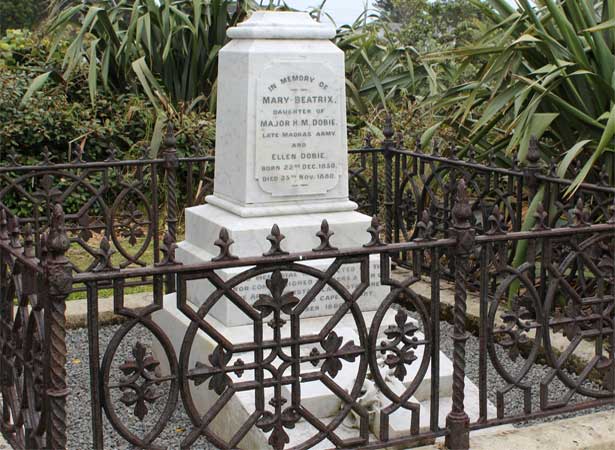
Tuhiata (Ngāti Ruanui, Tītahi; known as Tuhi) was hanged in Wellington for the murder of the artist Mary Dobie at Te Namu, near Ōpunake. He wrote to the governor of New Zealand a few days before his execution, asking that ‘my bad companions, your children, beer, rum and other spirits die with me’.
Mary Dobie was a gifted artist who produced many sketches of New Zealand scenery for The Graphic, a weekly illustrated newspaper published in London that was edited by her uncle, Arthur Locker. She was murdered on 25 November 1880 while visiting family at Ōpunake. She had walked 2 km north to Te Namu to sketch Mt Egmont/Taranaki for the Graphic. When she failed to return that evening, a search party was organised and around 9.30 p.m. her body was found.
Initial suspicion rested on Walter Stannard, a horse-breaker from Hāwera who had been seen in Ōpunake on the day of the killing with bloodstained clothes. He had also been one of the last people to see Dobie alive when they passed on the road. A coronial inquest cleared him of the crime after it was proved that the blood had come from his horse’s bleeding nose.
At the conclusion of this hearing, Stannard was released by the coroner ‘without a stain on your character’. Tuhi, who was also in custody after the discovery of a pair of bloodstained moleskin trousers at the crime scene, then confessed to killing Dobie.
Tuhi lived 6 km south of Ōpunake at Pūnehu, where his family grew potatoes and maize and raised pigs for sale. He had spent the morning drinking in an Ōpunake hotel where he had run up debts before – like Stannard – heading towards Te Namu to look for a runaway horse.
In the most plausible of several subsequent confessions, Tuhi said that when he met Dobie just north of Te Namu, he had no intention of committing a crime. Neither was fluent in the other’s language and Dobie became frightened. Thinking Tuhi was going to rob her, she gave him what little money she had on her. When she warned Tuhi that she would ‘tell the soldiers’ about him, he panicked. After trying to strangle her, he stabbed her as she tried to run away and then slit her throat.
The killing of a Pākehā woman by a Māori man known to have visited the independent community of Parihaka (25 km north of Ōpunake), which was vigorously resisting land confiscation, alarmed many. Was this outrage a prelude to war? The people of Parihaka had nothing to do with Mary Dobie’s death, but the tragedy was to be cited as a justification for the invasion of 5 November 1881.
In his summing-up, the judge at Tuhi’s trial for murder at the Supreme Court in Wellington, which began a fortnight after the killing, told the jury that the lack of an obvious motive was irrelevant if they were sure he had killed Dobie. His lawyer’s plea that Tuhi had drunk to excess on the fatal day was supported by only one witness. In any case, drunkenness was no defence against a charge of murder.
The jury took just 20 minutes to return a guilty verdict, and Tuhi was immediately sentenced to death by Chief Justice Prendergast. He would be hanged at the Terrace Gaol on 29 December.
A few days before the sentence was to be carried out, Tuhi wrote to Governor Arthur Gordon about the evil effects of alcohol. He may have been attempting to redeem himself in the eyes of Te Whiti o Rongomai of Parihaka, who had taken a stand against liquor because of its detrimental effects on Māori. Tuhi told an Anglican clergyman who visited him in prison just before his death that he was a follower of Te Whiti.
I have heard that I am to be put to death on Wednesday, and I am willing to die on that day, but I have a word to say to you. Let my bad companions, your children, beer, rum and other spirits die with me…; they led us to commit wrong, and now let us die together.
Read more on NZHistory
Capital punishment in New Zealand – The death penaltyNew Zealand crime timeline – Crime timeline
External links
How to cite this page
'Tuhiata hanged for murder of Mary Dobie', URL: https://nzhistory.govt.nz/hokianga-chief-patuone-arrives-in-sydney-to-establish-trade-contacts, (Ministry for Culture and Heritage), updated 3-Apr-2024
